Feature: No Rolex Can Compete With This Tudor
Rolex is famous for many things, not least its stubborn indifference to horology’s trickier complications.
“Tourbillons?” you can imagine it saying with the enthusiasm of someone who’s just been invited to an all-day conference on colostomy bags. “Not my thing, baby.”
“Perpetual calendars? Pfff! I’d rather spend my R&D millions working on a new variety of lightweight gold alloy, thanks very much.”
You would think, therefore, that the watches made by its famously more affordable sister brand Tudor boast even fewer complications. That it wouldn’t have the audacity to upstage its superstar sibling by making a function Rolex has never, to our knowledge, even attempted.
But that is exactly what the Tudor Heritage Advisor has done…
Alarming Development
In its 114-year history, Rolex has never released a watch with an alarm function—unlike Tudor, which launched its Advisor model all the way back in 1957, just 11 years after the brand was created by Rolex founder Hans Wilsdorf.

A Tudor Advisor reference 7926 from 1958. Image: Bonhams
At the time, and up until the 1970s, several brands were making alarm watches, including Jaeger-LeCoultre, Vulcain, Enicar and Angelus—although Eterna was the first to put an alarm clock in a wristwatch back in 1910.
In a pre-smartphone world it was a pretty useful function and you wonder why other, more illustrious brands didn't jump on the bandwagon.
It meant you didn’t need to pack a cumbersome alarm clock in your suitcase when you went away on a business trip. You could use it to get your boiled eggs just perfect, remind you of appointments when on the move, or when to pick up the kids from school.
For the average person, you could even say it was more useful than any of Rolex’s best-known complications. How many people back in the 1950s needed a GMT function, a diver’s watch with a bezel, or a chronograph?
The First Generations
The first-generation Heritage Advisor, reference 7926, was a simple-looking 36mm watch that functioned and looked like most alarm watches of the era. The crown at 2 o’clock was for setting and winding the alarm time while the one positioned at 4 o’clock was a standard crown for winding and setting the time.
Like Rolex, Tudor bought in its movements back then, and the Advisor was no different. However the alarm module that they attached to the movement, providing power separately, was made completely in-house—another Rolex-beating gold star for Tudor!

A model from 1958 with concentric dial and original Oyster steel bracelet. Image: Bonhams
A second-generation Advisor, reference 10050, hit the market in 1969 with a few design tweaks, but the quartz revolution was imminent, and by the 1970s most people requiring an alarm function on their watch opted for ones with digital LCD displays, whereby the alarm could be set more precisely.
By the late seventies the Advisor had gone into deep hibernation and its long-term future looked bleak, to say the least.
Roused From Its Slumber
At Baseworld 2011 Tudor delighted its fans by bringing back the Advisor, now part of its Heritage line. The reference 79620 took a few design cues from vintage models—including the familiar dial markers and red alarm hand—and introduced a useful power reserve indicator at 3 o’clock dedicated to the alarm function.
An on-off indicator, operated by a newly added pusher at 8 o’clock, was a welcome addition, ensuring the alarm wouldn’t start buzzing away at inopportune moments.
At 42mm, the case of contemporary models is bigger and made from titanium and steel rather than just steel, and it comes in three dial options: silver, cognac or black. One other new addition was a circular display for the date at 6 o'clock.

The new Heritage Advisor comes with a black, cognac or silver dial.
Also, whereas in older models the alarm fizzled out with a whimper, this time it buzzes for around 20 seconds (if fully wound) before coming to an abrupt neat stop.
Like previous models, the movement on the 79620 is bought in (from ETA) and then modded and fitted with an in-house alarm module.
Are They Still Relevant?
Granted, most of us no longer use a mechanical alarm to wake us up in the mornings. Most of us don’t even use a digital standalone device anymore. As with so many other things these days, our multi-tasking smart phones have taken on this role, coaxing us from our slumber with any number of sounds, from Peruvian pan-pipes to a chorus of chirping crickets.
Yet a mechanical alarm watch serves as a reassuring back-up to the alarm on our mobile phone.
When you're on a remote camping trip without electricity or you've simply left your charger on the train again, the trusty Advisor is waiting to save your bacon when that precious last bar on your phone's battery icon vanishes.

The new version features an alarm power reserve indicator.
There’s also the novelty aspect, of course. Few mechanical watches make any kind of sound apart from that faint ticking from the movement. Why not think of the alarm watch as a kind of budget minute repeater, making as much noise but in a less harmonious manner?
A monotonous thumping techno to the minute repeater’s intricate symphony, but a pleasing and tactile sound nonetheless for those who love all things mechanical.
And a sound, lest we forget, that no Rolex watches in the world are capable of making...
Looking for pre-owned Rolex finance? Click here to shop now
Looking for a pre-owned Rolex watch? Click here to shop now



